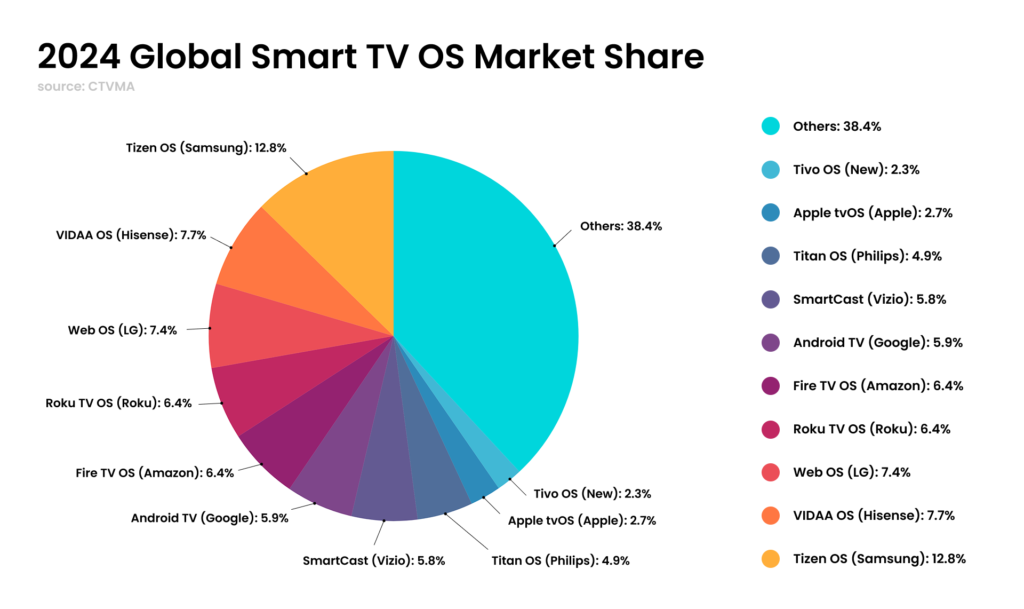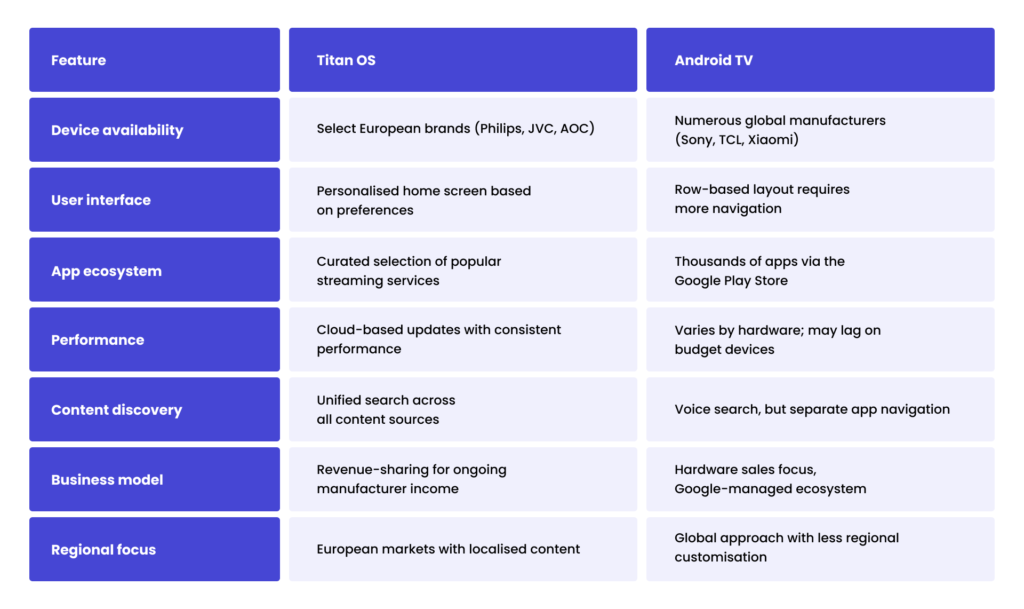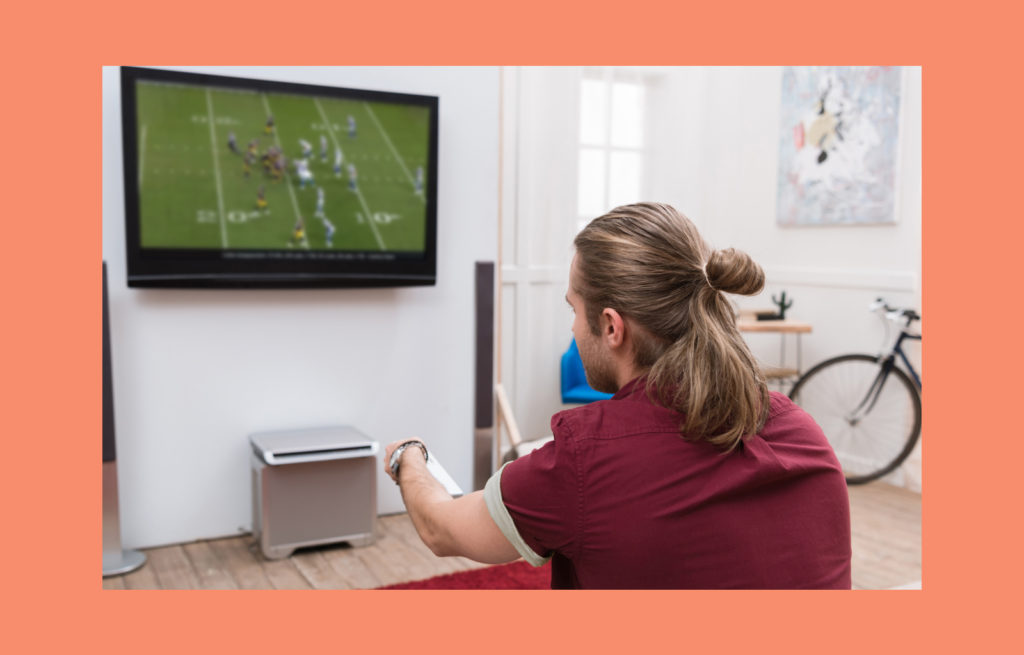Titan OS: how Europe’s independent TV platform is changing content delivery
The smart TV landscape is evolving, and a European challenger is gaining ground in a market long dominated by global giants. While Samsung’s Tizen OS leads with 12.8% of the worldwide market share, newcomer Titan OS has quickly secured 4.9% – surpassing Apple tvOS and approaching Android TV in just its first year of operation. This Barcelona-based platform is reshaping how content reaches European viewers through unique features like unified content search, personalised recommendations, and seamless integration of streaming services with traditional channels.
For media businesses looking to expand their European presence, Titan OS offers distinct advantages: a cloud-based infrastructure that ensures consistent performance, strategic partnerships with manufacturers like Philips and JVC, and a revenue-sharing model that benefits all ecosystem participants.
In this article, you’ll discover what Titan OS is, how it compares to Android TV, what developers need to know about creating applications for the platform, and how you can seize new opportunities in connected TV development.

What is Titan OS?
Titan OS is the first independent European operating system developed specifically for Connected TVs. Created by Titan OS S.L., a technology company based in Barcelona, this Linux-based platform serves as an alternative to proprietary systems in the TV market. Currently, Titan OS powers select TV models from manufacturers including Philips, JVC, and AOC, primarily in Europe.
The TV operating system functions as an interface layer between viewers and content, with a design philosophy centred on combining traditional broadcast channels with streaming services on a unified homepage. This integration aims to simplify content discovery by providing tailored recommendations based on viewing habits. Users can navigate content through multiple pathways, including the home page, Electronic Programme Guide (EPG), or direct remote control commands.
For television manufacturers, Titan OS offers a revenue-sharing business model and allows for customisation of the user interface to align with specific brand identities. The platform supports major favourite apps like Netflix, Disney+, and Prime Video, as well as various free channels from international and local broadcasting networks across Europe. This approach differs from other systems like Google TV or Android TV by emphasising continuous revenue streams while maintaining manufacturer control over customer relationships and data.
Key features of Titan OS
Titan OS personalises the viewing experience with an interface that dynamically adjusts to each user’s preferences and habits.
Viewer-adaptive interface
Titan OS places a significant emphasis on user profiles and delivering content based on preferences. The system creates a tailored home screen that adapts to individual viewing habits, making content discovery more intuitive and efficient. Unlike traditional interfaces that show the same layout for everyone, Titan OS learns from user interactions to surface relevant recommendations, helping users spend less time searching and more time enjoying their selected content.
Unified content ecosystem
One of Titan OS’s core strengths is its comprehensive approach to content integration. The platform combines streaming services, traditional broadcast channels, and online libraries in a unified interface. A standout feature is its global search functionality, which allows viewers to find movies or series across different platforms with a single click, eliminating the need to open multiple apps individually. This aggregation approach streamlines the entertainment experience for modern viewers who access content from various sources.
Dynamic cloud infrastructure
Unlike traditional TV operating systems that store applications locally, Titan OS employs a progressive cloud-based approach for system and application management. While updates are delivered through the cloud, applications are still installed locally on the device, ensuring optimal performance and offline accessibility.
Comprehensive entertainment portfolio
Titan OS provides access to an extensive library of popular streaming applications. The platform supports primary services including Netflix, Disney+, Prime Video, YouTube, Pluto TV, and region-specific options like BBC iPlayer, iTVX, ALL 4, and My5 for the UK market. This comprehensive app selection ensures that users can enjoy their favourite entertainment regardless of their preferred services, all from a single interface.
Autonomous advertising framework
As an independent operating system, Titan OS incorporates its own advertising infrastructure that operates separately from major tech ecosystems. This independence gives broadcasters and advertisers greater flexibility and control over ad delivery and placement, including ads on the homepage. For TV manufacturers and content providers, this represents an opportunity to develop continuous revenue streams while maintaining direct relationships with their audience.
Industry collaboration network
Through collaborations with major TV manufacturers like Philips (TP Vision) and other brands across Europe, Titan OS is expanding its reach in the TV market. These strategic partnerships enable the system to optimise performance for specific hardware configurations while allowing manufacturers to differentiate their products from competitors using more common systems like Android TV or WebOS.
Find out what makes Titan OS different
Learn moreWhy choose Titan OS?
Titan OS offers a unified, user-first experience that simplifies content discovery and ensures every service has a fair chance to reach the viewer.
- Integrated viewing journey: Titan OS eliminates the fragmentation of the modern entertainment landscape, creating a single destination where discovery seamlessly leads to enjoyment, without the frustration of switching between apps.
- Content democracy: By giving equal prominence to premium services and FAST channels, Titan OS ensures that quality entertainment is accessible to all viewers, regardless of their budget, creating a more inclusive media environment.
- Liberated from legacy constraints: Explicitly built for today’s connected environment without technical debt, Titan OS adapts readily to emerging formats and technologies that older systems struggle to incorporate.
- Evolving business value: For manufacturers and retailers, Titan OS transforms televisions from one-time purchases into platforms that generate continuous revenue streams throughout their lifecycle in consumers’ homes.
- European-focused design: Unlike global one-size-fits-all solutions, Titan OS is specifically tailored to the unique regulatory requirements, cultural preferences, and content ecosystems of European markets.
- Balanced ecosystem: Titan OS offers partners the cohesion of a unified platform while preserving their brand identity and customer relationships, avoiding the restrictive control of closed systems.
Titan OS vs Android TV: key differences
When choosing a smart TV or evaluating TV operating systems, it’s essential to understand the distinctions between platforms. Titan OS, the European independent operating system for connected TVs, takes a different approach to the viewing experience compared to, for example, the Android TV system.
While both platforms aim to deliver seamless access to streaming services and entertainment, they differ significantly in their design philosophy, functionality, and target markets. Here’s how these two TV operating systems compare across key dimensions:
- Device availability: Titan OS is currently limited to select European brands, including Philips, JVC, and AOC models. Android TV is implemented by numerous global manufacturers, including Sony, TCL, Xiaomi, and others, offering a greater variety of hardware and price points.
- User Interface: Titan OS aims to make content discovery more intuitive with a personalised viewing experience and a tailored home screen based on user preferences. Android TV employs a row-based layout organised by content categories, providing more information but potentially requiring more navigation to browse all options.
- App ecosystem: Titan OS includes popular streaming services but offers a more curated app selection. On the other hand, for example, Sony Android TVs provide access to the Google Play Store, which offers thousands of apps across various categories, providing users with substantially more options for niche applications.
- Performance optimisation: Titan OS employs cloud-based updates and a streamlined architecture that maintains consistent performance over time. Android TV can deliver excellent performance on high-end hardware, but it may experience lag on budget devices due to its resource requirements.
- Content discovery: Titan OS features unified global search functionality that works across streaming services, broadcast channels, and FAST content. Android TV offers Google Assistant voice search integration, but typically requires navigation between different apps for content discovery.
- Business model: Titan OS operates on a revenue-sharing model that creates ongoing income for manufacturers after device sales. Solutions like Sony Android TVs follow Google’s ecosystem approach, with manufacturers primarily benefiting from hardware sales and Google managing the platform’s ecosystem.
- Regional focus: Titan OS is specifically designed for European markets with localised content partnerships and regional broadcasting integration. Android TV takes a global approach with wider availability but potentially less regional customisation for specific markets.

Titan OS app development: what you need to know
Titan OS offers an accessible entry point for developers through its support for standard HTML5 and HbbTV technologies. Running on a Chromium browser environment, the platform provides compatibility with common web standards, making it remarkably approachable for teams with existing web development experience.
If your application already runs smoothly on other Linux-based TV platforms, you’ll find the transition to Titan OS refreshingly straightforward. The platform supports standard audio and video codecs, streaming protocols, and DRM options that work seamlessly with most existing video infrastructure. Notably, Titan OS supports major DRM technologies, including Google Widevine, Apple FairPlay, and Microsoft PlayReady.
That said, creating efficient TV applications does require some specialised knowledge, like:
- Interface design and navigation paths that work intuitively with directional controls
- Performance optimisation for consistent media playback across different network conditions
- Content security implementation that balances protection with usability
The journey to launching on Titan OS follows a clear path through their Partner Portal. After creating an account, you’ll submit your application for quality assurance testing, providing test URLS and necessary assets for publication. The initial “intake test” focuses on critical functionality, such as playback and navigation, followed by a more comprehensive evaluation if your app passes this first stage.
What makes this process manageable is the detailed feedback provided along the way. When issues arise, the Titan OS team offers specific steps to reproduce problems, practical suggestions for resolution, and visual examples that clarify exactly what needs attention.
Ready to expand your reach with Titan OS?
As this emerging European platform continues to grow its presence across Philips TVs, JVC, and AOC smart TVs, now is the ideal time to consider bringing your content to Titan OS. While the platform offers a familiar foundation of HTML5 technologies, successful development requires understanding the nuances of TV-specific design and navigating the certification process.
At Spyrosoft BSG, we combine our media expertise with our specialised Connected TV App Framework to streamline Titan OS development. Our team delivers solutions that balance technical excellence with business understanding, ensuring your content shines on the biggest screen in the house.
Explore how we can accelerate your Titan OS journey and learn more about our solutions for media and entertainment companies.
About the author
Contact us





![[thumbnail] media and entertainment - VOD vs OTT_ what is the difference](https://spyro-soft.com/wp-content/uploads/2025/04/thumbnail-media-and-entertainment-vod-vs-ott_-what-is-the-difference-min-1024x655.jpg)